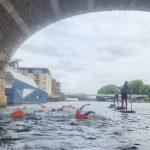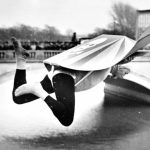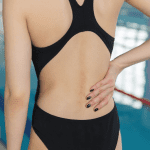How to do the perfect warm-up
The majority of swim training sessions start with a ‘warm-up’, so we thought we’d look at what a warm up is all about and how to do it properly.
The first part of the warm-up is the pose. The purpose here is to show off your perfect swimmer’s physique. At the pool, stand at the end of your chosen lane and stretch. Stand as tall as you can and reach both arms above your head in a tight streamline position. Then, lower your arms so your body makes a ‘T’ shape, pull your shoulder blades together and open up your chest. Next, lightly swing you arms. Stare down the lane to give the impression you’re psyching yourself up mentally to swim. Do not, under any circumstances, look at other people or check to see if they are admiring your body. For the extra professional look, shake out your arms or slap your hands on your chest. Put your hat and goggles on first, especially if you have sleek dark-tinted racing goggles. If you’re at a public session one of the aims here is to encourage other people in the lane to move aside before you even get in the water. If you’re swimming outside and wearing a wetsuit, only pull it up as far as your waist. From a swimming perspective, it’s probably better to put your suit fully on but that’s not the point here. Style is everything.
Step two is to make sure your lungs are working properly. If you’re swimming with other people the best way to do this is to chat and catch up on the latest swimming gossip. This is also the prime time to list your current injuries and excuses why you might not swim as fast as your massive potential promises. You are also, at this stage, trying to delay the moment when you actually get in the water.
How you get into the water says a lot about you both as a person and as a swimmer so think carefully how you do this. At the pool your options include climbing in at the steps, sitting on the side and sliding in, jumping or diving. If it’s safe to do so, I’d recommend diving, but make sure this is a real show-boat of a dive. Go for both height and distance and consider incorporating some kind of twitch or mini-tuck while you’re in the air. Fly. Try to hit the water cleanly. Take your time coming back to the surface. This is the moment to relax, let the water wash away your stress and tune in mentally to swimming but it also looks impressive if you can get half way down the pool without taking a single stroke. If you can’t dive in for any reason the next best option is to jump but don’t just step off the side, leap for joy and make as much splash as possible. Outside, jumping and diving may be precluded for safety reasons so you may be forced to wade in. Do so purposefully. However cold it is you need to turn to your swimming partners and say something like: “come on, it’s lovely.” Of course, if it is safe to dive or jump, do so with wild abandon. Alternatively, you can pray.
Coaches are liable to tell you some guff about how the warm-up prepares the body for hard training or gets you in tune with the water ready to swim. Forget it. The warm-up isn’t about you, it’s about the impression you make. In the pool it’s the perfect opportunity to stamp your authority on the lane, so make sure you swim with perfect technique and do everything to look as good as possible. Hopefully you’ll encourage a few more people to move to a different lane.
In open water you have other things to take into account – primarily the water temperature. In very cold water you won’t be training in any conventional sense so a warm-up is an irrelevant concept. You will be cooling down fast, so just get in, get on with it and get out. Make it look as if you don’t feel any pain or discomfort and never admit to being cold. In moderately cold water you should reach a point where you feel great in the water. You haven’t really warmed up but your body has adjusted to the conditions. The aim of the ‘warm-up’ is to reach this point in style – what type of style is up to you. Some people like to scream and shriek while others face it with grim determination. Choose the method that best suits the impression you want to convey. Shrieking and screaming is more fun so should probably be your default option but make sure you look like you’re enjoying yourself.
In warm water you may be tempted to treat the first part of your swim as a conventional warm-up similar to a pool training session. Don’t. Make the most of the warm-up to savour the delights of open water. Look around and enjoy your surroundings and take the opportunity while people are watching to show off your water skills. Twist, turn and dive like an otter to show that you are truly at home in the water and remember to include a few strokes of butterfly. This is especially important if you’re at a holiday resort beach where the majority of people are sunbathers not swimmers. Never look to see if anyone is watching. You don’t care, right?
Getting in is often the hardest part of the swim but knowing how to do the perfect warm-up makes it a little bit easier, and there’s a lot more to it than most people think. Now you know.






